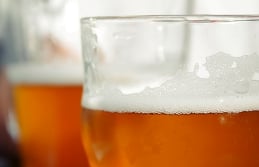
For many beer styles such as traditional ales, browns, porters and stouts, a full body beer style is very desirable. Full body beers have complex character, better head retention and enhanced mouthfeel. Higher body is achieved by raising the final gravity (FG) of a beer without producing an incomplete fermentation. Body can be enhanced by adding unfermentable (complex) sugars, and also by increasing the amount of protein in the brew. Making full body beer at home can easily be done if you use the following four tips:
Use more Carmelized and Roasted Malts
Malts that have been carmelized like caramel or crystal malts have long chains of sugars that are called dextrins. Even lighter caramel malts such as Carapils have dextrins in them. Dextrin sugars are carbohydrates that are almost tasteless, do not ferment, and subsequently remain in the finished beer enhancing the mouthfeel and perceived body to the brew. A pound of Carapils or caramel malt will significantly enhance the body of an average 5 gallon batch of beer. Malto-dextrin powder is another adjunct that can be added to enhance the amount of dextrin and therefore body of the beer. Roasted malt, chocolate, and special malts have a high proportion of other unfermentable sugars, and similarly increase the finished body while adding sweetness, raising FG, and enhancing flavor. This method works well for malt extract brewers as well as all grain brewers.
Add Unmalted Grains
Unmalted grains and many non-barley grains contain a large percentage of proteins. Examples include Wheat, Oatmeal, Flaked Barley, unmalted barley and undermodified malts. Proteins do not ferment and can have a profound effect on enhancing mouthfeel. Unfortunately proteins also reduce clarity of the finished beer, so large amounts of protein enhancing ingredients are best used in darker beers (Oatmeal Stout) or beers that are characteristically cloudy (many wheat beers). Note that many unmalted grains such as wheat, flaked grains and unmodified grains require mashing, and are not suitable for steeping in a malt extract beer.
Use a Higher Mash Temperature
A third method for enhacing beer body is to increase the temperature when mashing. A higher temperature during the saccrification step (convert at around 156-157F) will reduce the effect of the beta amylase enzyme leaving larger sugar chains in the beer. These long unfermentable sugar chains will remain in the beer resulting in a higher final gravity and enhanced body. If you are using BeerSmith, simply select any of the “Full Body” mash profiles to convert your mash at a higher temperature.
Use a Low Attenuation Yeast Strain
Select a brewing yeast strain with low average attenuation. Low attenuating yeasts will consume fewer complex sugars leaving a higher final gravity and ultimately a beer with more body. Select a yeast with average attenuation below 70% if possible. Examples of low attenuation yeast include many English, European and traditional ale yeasts, Alt and many of the English and British ale yeast variants.
Combine all four of these methods for your next complex English Ale, Porter or Stout to make a full bodied beer! Have a great week and happy brewing!
i need wt increasing beer brand
Pingback: Jessika Legum